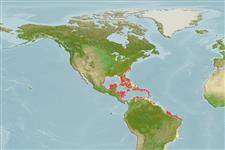>
Carangiformes (Jacks) >
Carangidae (Jacks and pompanos) > Caranginae
Etymology: Caranx: French, carangue, the name of a Caribbean fish; 1836 (Ref. 45335).
More on author: Bloch.
Environment: milieu / climate zone / depth range / distribution range
Ekologi
laut berasosiasi dengan karang; oceanodromus (Ref. 51243); kisaran kedalaman 0 - 35 m (Ref. 40849), usually 0 - 22 m (Ref. 9710). Subtropical; 35°N - 33°N, 100°W - 33°W
Western Atlantic: New Jersey (USA), Bermuda, and Gulf of Mexico to southern Brazil; throughout the Caribbean Sea (Ref. 9626). Most common in the West Indies (Ref. 26938).
Length at first maturity / Size / Weight / umur
Maturity: Lm 31.0, range 26 - ? cm
Max length : 73.0 cm FL jantan/; (Ref. 6937); common length : 50.0 cm TL jantan/; (Ref. 5217); Berat maksimum terpublikasi: 8.2 kg (Ref. 3277)
deskripsi pendek
Kunci identifiaksi (pengenalan) | Morfologi | Morfometrik
Duri punggung (Keseluruhan (total)) : 8 - 9; duri punggung lunak (Keseluruhan (total)) : 26 - 30; Duri dubur: 2 - 3; Sirip dubur lunak: 23 - 26.
Common in clear insular areas or in coral reefs off mainland coasts (Ref. 5217). Juveniles frequent areas with algae (e.g. Sargassum) (Ref. 26235). Usually in schools which may be spawning groups; occasionally solitary. Feeds on fishes, shrimps and other invertebrates. Marketed fresh (Ref. 56217). Easily approached (Ref. 9710). Large individuals have caused ciguatera when eaten (Ref. 13442).
Berry, F.H. and W.F. Smith-Vaniz, 1978. Carangidae. In W. Fischer (ed.) FAO species identification sheets for fishery purposes. West Atlantic (Fishing Area 31). volume 1. FAO, Rome. [var. pag.]. (Ref. 3277)
Status IUCN Red List (Ref. 130435: Version 2024-2)
ancaman kepada manusia
Reports of ciguatera poisoning (Ref. 30302)
penggunaan manusia
Perikanan: komersial; Ikan buruan: ya
Alat, peralatan
laporan khas
muat turun XML
Sumber internet
Estimates based on models
Preferred temperature (Ref.
123201): 23.2 - 28, mean 26.8 °C (based on 420 cells).
Phylogenetic diversity index (Ref.
82804): PD
50 = 0.5000 [Uniqueness, from 0.5 = low to 2.0 = high].
Bayesian length-weight: a=0.01549 (0.01271 - 0.01887), b=2.95 (2.92 - 2.98), in cm total length, based on LWR estimates for this species (Ref.
93245).
Trophic level (Ref.
69278): 4.3 ±0.1 se; based on diet studies.
Generation time: 7.7 ( na - na) years. Estimated as median ln(3)/K based on 1
growth studies.
Daya lenting (Ref.
120179): sedang, Waktu penggandaan populasi minimum 1.4 - 4.4 tahun (K=0.14-0.24; tm=3; Fec=800,000).
Fishing Vulnerability (Ref.
59153): High vulnerability (57 of 100).
Climate Vulnerability (Ref.
125649): Very high vulnerability (84 of 100).
Nutrients (Ref.
124155): Calcium = 13.4 [5.4, 24.9] mg/100g; Iron = 0.347 [0.166, 0.748] mg/100g; Protein = 20.6 [18.2, 23.0] %; Omega3 = 0.17 [0.09, 0.32] g/100g; Selenium = 16.9 [6.9, 41.2] μg/100g; VitaminA = 62.4 [20.7, 184.8] μg/100g; Zinc = 0.341 [0.224, 0.543] mg/100g (wet weight);
